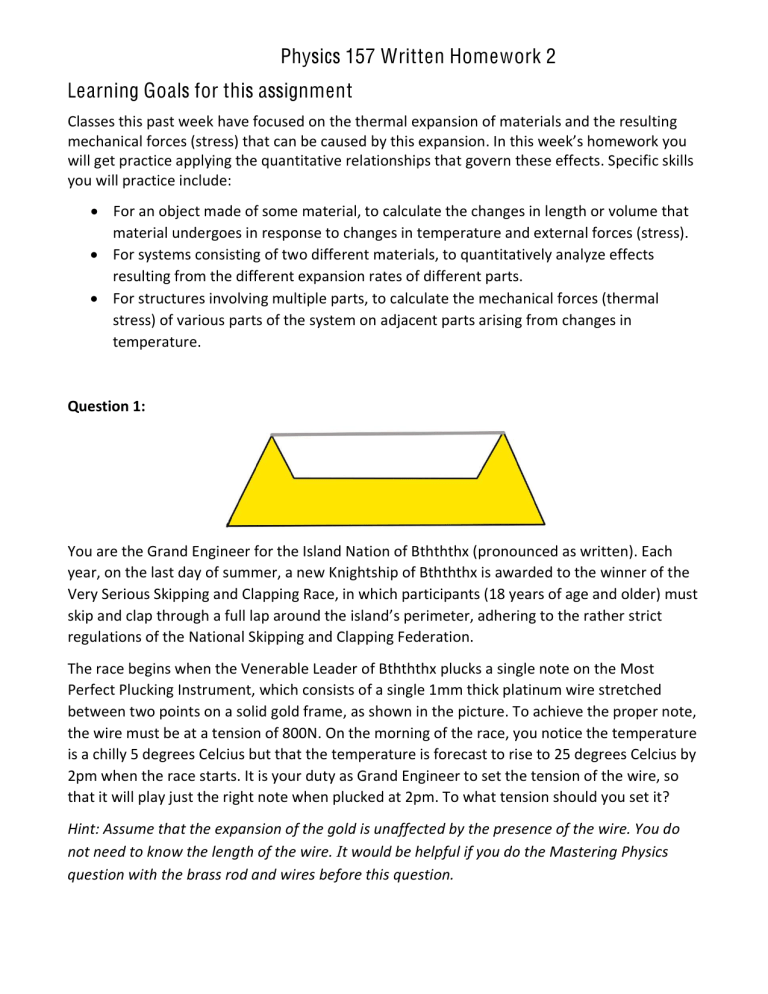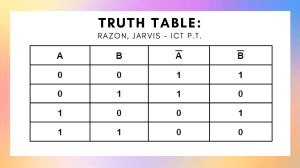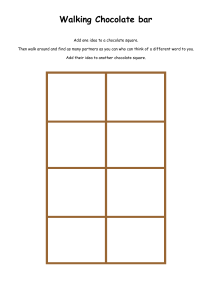
Physics 157 Written Homework 2 Learning Goals for this assignment Classes this past week have focused on the thermal expansion of materials and the resulting mechanical forces (stress) that can be caused by this expansion. In this week’s homework you will get practice applying the quantitative relationships that govern these effects. Specific skills you will practice include: For an object made of some material, to calculate the changes in length or volume that material undergoes in response to changes in temperature and external forces (stress). For systems consisting of two different materials, to quantitatively analyze effects resulting from the different expansion rates of different parts. For structures involving multiple parts, to calculate the mechanical forces (thermal stress) of various parts of the system on adjacent parts arising from changes in temperature. Question 1: You are the Grand Engineer for the Island Nation of Bthththx (pronounced as written). Each year, on the last day of summer, a new Knightship of Bthththx is awarded to the winner of the Very Serious Skipping and Clapping Race, in which participants (18 years of age and older) must skip and clap through a full lap around the island’s perimeter, adhering to the rather strict regulations of the National Skipping and Clapping Federation. The race begins when the Venerable Leader of Bthththx plucks a single note on the Most Perfect Plucking Instrument, which consists of a single 1mm thick platinum wire stretched between two points on a solid gold frame, as shown in the picture. To achieve the proper note, the wire must be at a tension of 800N. On the morning of the race, you notice the temperature is a chilly 5 degrees Celcius but that the temperature is forecast to rise to 25 degrees Celcius by 2pm when the race starts. It is your duty as Grand Engineer to set the tension of the wire, so that it will play just the right note when plucked at 2pm. To what tension should you set it? Hint: Assume that the expansion of the gold is unaffected by the presence of the wire. You do not need to know the length of the wire. It would be helpful if you do the Mastering Physics question with the brass rod and wires before this question. Question 2 In your first assignment as Chief Dessert Engineer for the United Cookie Corporation, you design a cookie whose interior is a layer of marshmallow surrounded by a ring of chocolate. The top and bottom are round graham crackers, to which the marshmallow and chocolate are attached securely. After the graham crackers are attached, and the entire cookie is in equilibrium at 10 oC, there is no stress in the marshmallow or chocolate. The chocolate will separate from the graham cracker if the (vertical) tensile stress in the chocolate exceeds 1.3 × 103 Pa. What is the maximum temperature increase the cookies can withstand without the chocolate separating? Marshmallow: Y = 1.0 × 104 Pa, α = 0.0025K-1 Chocolate: Y = 1.5 × 105 Pa and α = 0.0010K-1 Assume the graham cracker does not bend and ignore effects related to expansion in the horizontal directions. Homework tips: It’s usually very helpful to start by drawing before/after pictures and labeling with the various known/unknown quantities. We can introduce variables to gives names to the various known and unknown things. It’s often simpler to wait and plug in numbers at the end. Thermal expansion / thermal stress problems: For these, it’s useful to first consider each part of the system separately. For each part, the change in length (or any linear dimension) is equal to the change in length due to thermal expansion plus the change in length due to the changing forces: ΔL = α L0 ΔT + (ΔF/A)( L0/Y) Sometimes, one of these terms will be zero (e.g. if we can ignore external forces on part of the system). This will give you one equation for each part of the system. Next look at the setup of the problem to understand how the changes in length for various parts are related to each other, and how the various forces are related to each other. For example, changes in length for two parts of the system might be equal to each other, or add to zero. The forces can be related by Newton’s third law or by the fact that the net force is zero on static objects. These constraints will give you the remaining equations you need to solve for your unknowns. Old midterm questions on thermal expansion and thermal stress (try some if you want extra practice, not to be handed in) You’ve just come up with a new design for a lightweight bicycle wheel with an aluminum rim (α = 13 × 10-6) and steel spokes (α = 7 × 10-6 , Y = 20 × 1010Pa). At 5 degrees Celcius, there is no tension in spokes, but thermal expansion results in a tensile force as shown. If we want this force to be less than 180N for temperatures up to 35ºC, what is the maximum cross sectional area (in mm2) that the spokes can have? Question 2 (from an old exam): Two pillars, separated by 2m, have a cord strung between them that consists of two different wires attached to each other, a 5mm diameter nylon wire and a 1mm diameter copper wire. At the initial temperature of 25oC, there is 100N of tension in the wire. a) If the temperature drops to 5oC, by how much does the joining point of the two wires move? b) What is the final tension in the wires? For nylon, we have Y = 3GPa and α = 5 × 10-5 K-1 For copper, we have Y = 117GPa and α = 1.6 × 10-5 K-1




